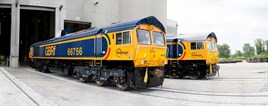Five brand new GB Railfreight Class 66s (66752-66756) have left the Electro-Motive Diesel factory in Muncie (Indiana), made the 700-mile trip to the US East Coast port of Norfolk (Virginia), and were expected to begin their journey across the Atlantic as RAIL went to press.
The first five of 21 Class 66s that are on order were coupled together on June 13.
They were hauled by a Norfolk Southern SD70 on the Norfolk Southern Railway that connects Muncie to the port in Norfolk, where they arrived on June 17.
From there, the ‘66s’ were loaded onto the Intermarine HR Resolution, to be shipped across ‘the pond’. Loading began on June 18, and was expected to take two days. The ship was then due to set sail on the evening of June 20-21.
It is expected that the HR Resolution will take between 12 and 15 days to make the crossing to Newport, arriving at its south Wales destination in the first or second week of July. The locomotives will then be unloaded and coupled together again (taking a further two or three days), before being taken directly to the new EMD maintenance depot at Doncaster Roberts Road.
All five ‘66s’ will be put into the GBRf fleet, rather than being specified to a particular role. However, they are required to fulfil the National Delivery Service contract GBRf has won with Network Rail (RAIL 742), so the intention is for the first five to go straight into service on this contract from July 7.
During RAIL’s visit to the Muncie factory, GBRf Managing Director John Smith said that work was already in place for 15 of the 21 locomotives, with plenty of opportunity to allocate the final six.
Essentially, the new Class 66s are the same as those built previously, but they are all-American, as opposed to part-Canadian (like the previous members of the class, which were built in London, Ontario). All 21 are being assembled by EMD at the Muncie factory, with parts - including the engines - coming from EMD’s factory at LaGrange, Chicago.
There are some small changes from previous members of the class. The new locomotives have all the UK-compliant signalling equipment needed, as well as air-conditioning. The engines now have a secondary cooling system, to allow them to hit current emissions targets. And control panels in the cabs have a slightly different layout to make them more ergonomic for the driver, which will require some minimal driver training.
Smith said the new locomotives would mean the business “should grow by 100 souls in the next 12 months”, taking the head count to around 700 people by this time next year. This is down not only to the purchase of these Class 66s, but also the 16 second-hand ‘92s’ bought in February (RAIL 741). Of the new staff, 30 will be drivers for the Class 66s.
He said the deals provide “the security of growth of my business for probably another two years”.














Login to comment
Comments
No comments have been made yet.